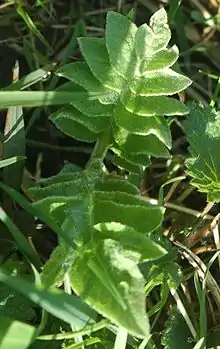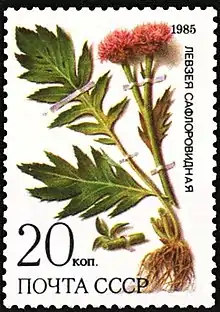Rhaponticum carthamoides
Rhaponticum carthamoides, also known as Maral root or Rhaponticum, is an herbaceous perennial plant from the family Asteraceae[2] that inhabits the sub-alpine zone (4,500–6,000 ft (1,400–1,800 m) above sea level) as well as alpine meadows. It can be found growing wild in Southern Siberia, Kazakhstan, the Altay region, and Western Sayan Mountains. Maral root is widely cultivated throughout Russia and Eastern Europe. This plant derives its traditional name Maral root (Maralu) from the maral deer who fed on it.
| Maral root | |
|---|---|
 | |
| Scientific classification | |
| Kingdom: | Plantae |
| Clade: | Tracheophytes |
| Clade: | Angiosperms |
| Clade: | Eudicots |
| Clade: | Asterids |
| Order: | Asterales |
| Family: | Asteraceae |
| Genus: | Rhaponticum |
| Species: | R. carthamoides |
| Binomial name | |
| Rhaponticum carthamoides | |
| Synonyms[1] | |
| |
R. carthamoides is high in 20-hydroxyecdysone,[3] one of the most common molting hormones in insects, crabs, and some worms and 20E can disrupt their molting and reproduction.

1985 USSR stamp, depicting Rhaponticum carthamoides
References
- "Rhaponticum carthamoides". Germplasm Resources Information Network (GRIN). Agricultural Research Service (ARS), United States Department of Agriculture (USDA). Retrieved 2008-02-23.
- SysTax - detailed information on Rhaponticum carthamoides (Willd.) Iljin
- Głazowska J, Kamiński MM, Kamiński M. Chromatographic separation, determination and identification of ecdysteroids: Focus on Maral root (Rhaponticum carthamoides, Leuzea carthamoides). J Sep Sci. 2018 Dec;41(23):4304-4314. doi: 10.1002/jssc.201800506. Epub 2018 Nov 2. PMID: 30303602.
This article is issued from Wikipedia. The text is licensed under Creative Commons - Attribution - Sharealike. Additional terms may apply for the media files.